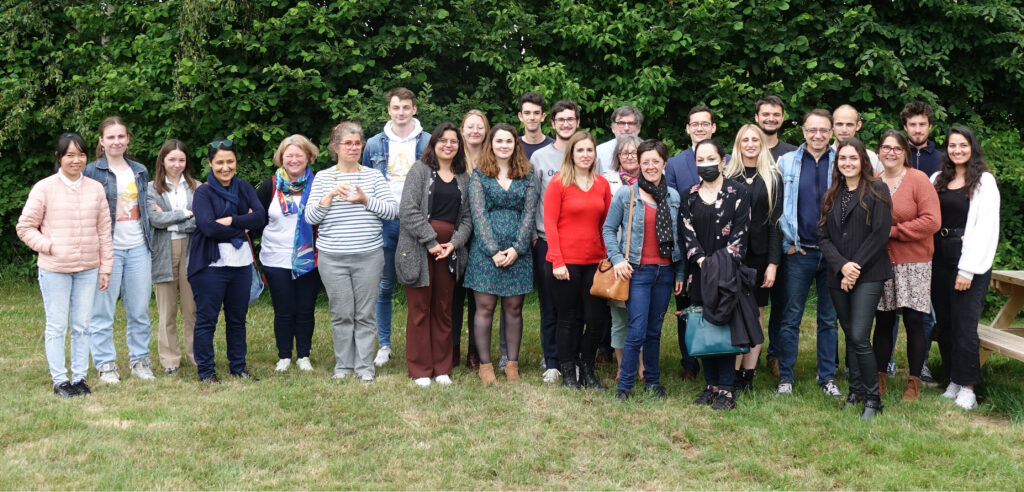Metals, Diseases and vectorised therapies

Team leaders:
Pascal Loyer & Pascal Guggenbuhl
Essential metals such as iron, copper and zinc are required for proper physiology. However, disruption of metal homeostasis for instance in genetic iron overload diseases, induces liver, heart and pancreas damages and contributes to bone and joint lesions. Secondary iron overload observed during hematological disorders or metabolic syndrome may also contribute to lesions occurrence. The maintenance of metal homeostasis implies a tightly controlled regulation of their systemic and cell metabolisms, as illustrated for iron metabolism, which results from equilibrium between amounts absorbed by the gastrointestinal tract, losses, storage, and proper addressing of iron in the different cells and organs.
Other metals, including rare-earth and transition metals are increasingly used as stable isotopes to create cytotoxic drugs or as radionucleides for applications in theranostics and therapy in oncology. Metal-based therapies are undoubtedly promising approaches for clinical applications in cancer vectorized therapy when combined to synthetic molecules, nanoparticles or microspheres that allow site specific addressing. The cellular status in essential metals could modulate the effects of this therapy.
Our objectives are to further characterize iron-related diseases and the mechanisms involved in these diseases, including the analysis of interactions with microbiota and other metals, and to further develop metal-based therapies of liver cancers, especially by studying links with essential metal metabolisms. The following themes are explored:
Theme 1: Iron-related diseases, Metals and Microbiota. Our main focus is the iron metabolism diseases with the goal to understand how genetic, nutritional factors and microbiota modulation contribute to the phenotypic modulation of iron overload diseases. We study the cross regulation between iron and other metals metabolisms and the respective impact of iron and other metals on iron-related osteoporosis in link with the hepcidin level. The interactions between microbiota and cell host is investigated by studying intestinal and oral microbiota and how the host iron status modulates the microbiota and impacts the occurrence/progression of diseases, and how the modulation of bacterial community affects iron metabolism.
Theme 2: Metals and Vectorized therapies in liver cancers. In order to improve efficacy and tolerance of liver cancers therapies, we develop novel peptide-chelator conjugates, nanoparticles, bacterial magnetosomes for innovative vectorized therapies as well as radioactive metal-based microspheres and lipiodol for radioembolization of hepatocellular carcinomas. We also study how genetic and acquired factors modulate the efficacy and tolerance of treatments using metals.
These two themes share several key words including “iron”, “metals”, “metabolism”, “iron-related diseases”, “redox status” and “therapeutic metals”. These studies rely on the use of original in vitro models including bacteria-human cell coculture systems and wild type and transgenic rodent models, and include clinical trials conducted at the Hospital and the cancer center in Rennes with the ultimate objective to implement novel therapies of iron-related diseases and liver cancers.

Recent Publications :
- Fallet E., Rayar M., Landrieux A., Camus C., Houssel-Debry P., Jezequel C., Legros L., Uguen T., Ropert-Bouchet M., Boudjema K., Guyader D., Bardou-Jacquet E. (2020) Iron metabolism imbalance at the time of listing increases overall and infectious mortality after liver transplantation. World J Gastroenterol, vol 26, n°16, 1938-1949 p., DOI: https://doi.org/10.3748/wjg.v26.i16.1938.
- Berthoud O., Coiffier G., Albert J.D., Jolivet-Gougeon A., Goussault C., Bendavid C., Guggenbuhl P. (2020) Performance of a new rapid diagnostic test the lactate/glucose ratio of synovial fluid for the diagnosis of septic arthritis. Joint Bone Spine, vol 87, n°4, 343-350 p., DOI: https://doi.org/10.1016/j.jbspin.2020.03.009.
- Casajus H, Dubreucq E, Tranchimand S, Perrier V, Nugier-Chauvin C, Cammas-Marion S. Lipase-Catalyzed Ring-Opening Polymerization of Benzyl Malolactonate: An Unusual Mechanism? Biomacromolecules. 2020 Jun 30. doi: 10.1021/acs.biomac.0c00593.
- Edeline J, Garin E. Streamlining TARE or personalizing SIRT? Different philosophies to treat different HCCs with Yttrium-90. J Hepatol. 2020 Jun;72(6):1046-1048. doi: 10.1016/j.jhep.2020.03.026.
- Vernay T, Cannie I, Gaboriau F, Gall SD, Tamanai-Shacoori Z, Burel A, Jolivet-Gougeon A, Loréal O, Bousarghin L. (2020). Bacteroides fragilis prevents Salmonella Heidelberg translocation in co-culture model mimicking intestinal epithelium. Benef Microbes, vol 11, n°4, 391-401. doi: 10.3920/BM2020.0004.
- Kenawi M., Rouger E., Island M.L., Leroyer P., Robin F., Remy S., Tesson L., Anegon I., Nay K., Derbre F., Brissot P., Ropert M., Cavey T., Loreal O. (2019) Ceruloplasmin deficiency does not induce macrophagic iron overload: lessons from a new rat model of hereditary aceruloplasminemia. FASEB J, vol 33, n°12, 13492-13502 p., DOI: https://doi.org/10.1096/fj.201901106R.
- Hamdi-Roze H., Ben Ali Z., Ropert M., Detivaud L., Aggoune S., Simon D., Pelletier G., Deugnier Y., David V., Bardou-Jacquet E. (2019) Variable expressivity of HJV related hemochromatosis: “Juvenile” hemochromatosis? Blood Cells Mol Dis, vol 74, n°, 30-33 p., DOI: https://doi.org/10.1016/j.bcmd.2018.10.006.
- Salem R., Padia S. A., Lam M., Bell J., Chiesa C., Fowers K., Hamilton B., Herman J., Kappadath S. C., Leung T., Portelance L., Sze D., Garin E. (2019). Clinical and dosimetric considerations for Y90 recommendations from an international multidisciplinary working group. European Journal of Nuclear Medicine and Molecular Imaging, vol 46, n°8, 1695-1704 p.. DOI: https://doi.org/10.1007/s00259-019-04340-5.
- Cavey T., Latour C., Island M.L., Leroyer P., Guggenbuhl P., Coppin H., Roth M.P., Bendavid C., Brissot P., Ropert M., Loreal O. (2019) Spleen iron, molybdenum, and manganese concentrations are coregulated in hepcidin-deficient and secondary iron overload models in mice. FASEB J, vol 33, n°10, 11072-11081 p., DOI: https://doi.org/10.1096/fj.201801381RR.
- Peltier L., Bendavid C., Cavey T., Island M.L., Doyard M., Leroyer P., Allain C., De Tayrac M., Ropert M., Loreal O., Guggenbuhl P. (2018) Iron excess upregulates SPNS2 mRNA levels but reduces sphingosine-1-phosphate export in human osteoblastic MG-63 cells. Osteoporos Int, vol 29, n°8, 1905-1915 p., DOI: https://doi.org/10.1007/s00198-018-4531-8.
- Boyer E., Le Gall-David S., Martin B., Fong S.B., Loreal O., Deugnier Y., Bonnaure-Mallet M., Meuric V. (2018) Increased transferrin saturation is associated with subgingival microbiota dysbiosis and severe periodontitis in genetic haemochromatosis. Sci Rep, vol 8, n°1, 15532 p., DOI: https://doi.org/10.1038/s41598-018-33813-0.
- Quesnot N., Bucher S., Gade C., Vlach M., Vene E., Valença S., Gicquel T., Holst H., Robin M.-A., Loyer P. (2018). Production of chlorzoxazone glucuronides via cytochrome P4502E1 dependent and independent pathways in human hepatocytes. Archives of Toxicology, vol 92, n°10, 3077-3091 p.. DOI: https://doi.org/10.1007/s00204-018-2300-2.





